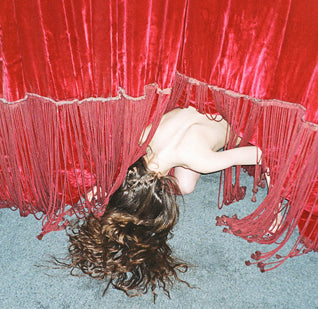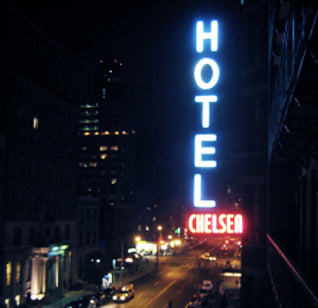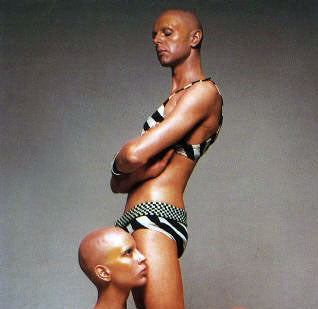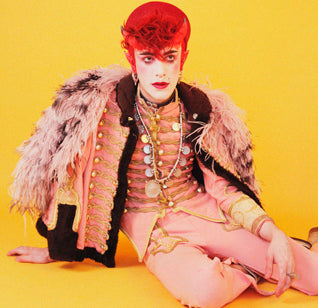THE ONLINE REVOLUTION
Subculture and style: the disappearing act
by Rob Greer
What’s happened to subculture? Evidence of past counter-cultural groups can be seen in towns and city centers everywhere, but they are diluted visions of the past. Today you can buy the identical leather jacket and drainpipe jeans worn on every Ramones album, however, by doing so you are representing consumerism through a fashion statement rather than a set of ideals. Does this mean that subculture is dead, or has youth culture moved on from easily recognizable stereotypes?
All culture is simplified by the media: our understanding of past trends is rooted in images rather than ideas. With TV and magazines regurgitating styles of subcultures in an effort to sell products, it is inevitable that these images become separated from the ideas that created them. For example, the stripped down look of the 60’s skinheads was a statement of pride in working class roots, as well as a reaction to Britain’s new found multiculturalism. Today, we see boys shave their heads and wear braces on a whim – it’s a hollow fashion statement, executed without thought.

In the face of our turbulent economy, subcultures struggle to survive in the midst of rising living costs. In the early 1970s many German artists who pioneered electronic music lived in abandoned buildings or paid very cheap rent, the group Harmonia for example lived in isolation in rural Forst, with an army of synthesizers and only a large oven for heating.
Today, stricter legislation makes this style of living impossible and even “successful” bands struggle to make money, putting musicians under enormous pressure to create tracks which are immediately profitable. Backed into a corner by the bank, creative people no longer have the time or freedom to make their art truly unique.
Although it would be difficult to class the 1970s German avant-garde as a subculture, they do offer an example of communal living, a sharing of ideas and a complete dedication to art - a recipe for the organic creation of subculture. A similar counter-cultural group was The Merry Pranksters, a loose group of artists and outcasts led by Ken Kesey, author of “One Flew over the Cuckoo’s Nest”, that lived communally in California in the early 1960s.
All culture is simplified by the media: our understanding of past trends is rooted in images rather than ideas.
They traveled across America for months with the psychedelic-rock band, The Grateful Dead, putting on music and light shows that they called ‘The Acid Tests’. They had a different, bohemian way of dressing, a pacifist political stance, and a gurgling, dream-like take on guitar music.
These trips across the country lit the fuse for the hippy subculture, providing an alternative lifestyle and message for others to admire and aspire towards. The look and the music however, were the aspects that seeped most successfully into the mainstream culture.
Nowadays, subculture has moved away from the arts and music and into areas such as internet culture and so-called hacktivist networks. Hidden behind their screens, members of online groups are much more difficult to identify visually than traditional subcultures, awarding them a degree of anonymity.

Rejecting aesthetics, these invisible figures adhere to the ethos of the internet – their collectives are accessible and democratic. Online groups welcome members no matter what they look like, although certain skills are often required: it is impossible to infiltrate many of the high profile networks without talents in hacking or coding.An example of a high profile hacktivist network is the group Anonymous.
Like the Merry Pranksters, Anonymous expresses itself through tricks and pranks – sending huge amounts of pizza to the doors of political opponents and shutting down websites they oppose, including those of Mastercard, The Church of Scientology, and child pornography. Described as “digital robin hoods” by CBC News, the collective’s mischief stretches beyond the virtual world, arranging protests in ‘real life’ and popularizing the Guy Fawkes mask.
During the internet black out in North Africa in the midst of the Arab spring, they broadcasted information to the West and helped those on the ground communicate - revealing how constructive they could be in their counter-cultural activity. In 2012, TIME Magazine included the group in their list of 100 Most Influential People, but their lack of a recognizable aesthetic or any artistic product, other than memes, sees them fearfully perceived as cultural terrorists, rather than a cultural group.

The author Dan Hancox – who has written extensively on subcultures – has suggested that the lack of a widely recognized subculture is due to the increased number of voices in society: “There isn't just one uniform hegemonic culture but several, overlapping ones, so there will never be one holistic counter-culture. Put simply, there is more than one show in town, and that's how it will stay”.
Up against rising living costs and thoughtless style, subculture as we know it has moved on. Now it exists on the internet, a platform which welcomes new voices to the public realm, as well as providing the curious with access to almost infinite information and music. As such, it is inevitable that youth culture will draw from a much wider pool of influences than in the past, resulting in groups that are more temporary than traditional subcultures and are less easy to recognize.
The relation between art and subcultures feed off each other, inspiring us to question and aspire to something better. Frankly, the migration of subculture to the internet is a loss to art and music. Art helps us communicate our ideas on a more personal level that lasts for decades. Subcultures force us to question the norms within the arts and society – which today are in need of greater authentic creativity.




































